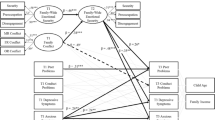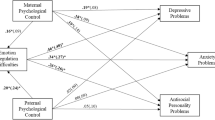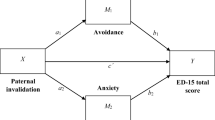Abstract
Findings from decades of research suggest that a perceived lack of parental care and overprotection are positively related to later symptoms of emotional disorders in children and adolescents. The present study used a cross-sectional design to evaluate models investigating reported family environment during childhood, current attachments, control-related cognitions, and current symptoms of emotional disorders in adolescence. It was hypothesized the effect of a perceived controlling and rejecting family environment during childhood would influence current depression and anxiety, and that these effects would be partially accounted for by the quality of current attachments, perceived control, and attributional style. A sample of 234 university students was assessed. Regression analyses of variables, including analyses of indirect effects, were conducted. As predicted, current attachment, perceived control, and attributional style helped to account for relationships between some family variables, and depression and anxiety. Findings are discussed with respect to the interplay of family variables and models of emotional disorders.
Similar content being viewed by others
Notes
Overall, attributional style accounted for the relationship between family conflict and AA. However, given that previous regression analyses revealed that the relationship between family conflict and anxious arousal was only significant for females, we presented the results for this test of indirect effects for females only.
References
Abramson, L. Y., Metalsky, G. I., & Alloy, L. B. (1989). Hopelessness depression: A theory-based subtype of depression. Psychological Review, 96, 358–372.
Abramson, L. Y., Seligman, M. E. P., & Teasdale, J. D. (1978). Learned helplessness in humans: Critique and reformulation. Journal of Abnormal Psychology, 87, 49–74.
Alloy, L. B., Abramson, L. Y., Whitehouse, W. G., Hogan, M. E., Panzarella, C., & Rose, D. T. (2006). Prospective incidence of first onsets and recurrences of depression in individuals at high and low cognitive risk for depression. Journal of Abnormal Psychology, 115, 145–156.
American Psychiatric Association. (1987). Diagnostic and statistical manual of mental disorders (3rd ed., revised). Washington, DC: American Psychiatric Association.
Beautrais, A. L., Joyce, P. B., & Mulder, R. T. (1999). Personality traits and cognitive styles as risk factors for serious suicide attempts among young people. Suicide and Life-Threatening Behavior, 29, 37–47.
Bilfulco, A., Moran, P. M., Ball, C., & Bernazzani, O. (2002). Adult attachment style I:Its relationship to clinical depression. Social Psychiatry and Psychiatric Epidemiology, 37, 50–59.
Bowlby, J. (1973). Attachment and loss: Separation, anxiety and anger. New York: Basic Books.
Bowlby J. (1977). The making and breaking of affectional bonds: I Aetiology and psychopathology in the light of attachment theory. British Journal of Psychiatry, 130, 201–210.
Bowlby, J. (1988). A secure base: Parent–child attachment and healthy human development. New York: Basic Books.
Buchanan, G. M., & Seligman, M. E. P. (1995). Explanatory style. Hillsdale, NJ: Lawrence Erlbaum.
Carnelley, K. B., Pietromonaco, P. R., & Jaffe, K. (1994). Depression, working models of others, and relationship functioning. Journal of Personality and Social Psychology, 66, 127–140.
Chorpita, B. E., & Barlow, D. H. (1998). The development of anxiety: The role of control in the early environment. Psychological Bulletin, 124, 3–21.
Chorpita, B. F., Brown, T. A., & Barlow, D. H. (1998). Perceived control as a mediator of family environment in etiological models of childhood anxiety. Behavior Therapy, 29, 457–476.
Clark, L. A., & Watson, D. (1991). Tripartite model of anxiety and depression: Psychometric evidence and taxonomic implications. Journal of Abnormal Psychology, 100, 316–336.
Clarke, D. (2004). Neuroticism: Moderator or mediator in the relation between locus of control and depression? Personality & Individual Differences, 37, 245–258.
Collins, N. L., & Read, S. J. (1990). Adult attachment, working models, and relationship quality in dating couples. Journal of Personality and Social Psychology, 58, 644–663.
Costa, P. T. Jr., & McCrae, R. R. (1992). Revised NEO Personality Inventory (NEO-PI-R) and NEO Five-Factor Inventory (NEO-FFI) professional manual. Odessa, FL: Psychological Assessment Resources.
Geisser, M. E., Cano, A., & Foran, H. (2006). Psychometric properties of the Mood and Anxiety Symptom Questionnaire in patients with chronic pain. Clinical Journal of Pain, 22, 1–9.
Gerlsma, C., Emmelkamp, P. M., & Arrindell, W. A. (1990). Anxiety, depression, and perception of early parenting: A meta-analysis. Clinical Psychology Review, 10, 251–277.
Gittleman, M. G., Klein, M. H., Smider, N. A., & Essex, M. J. (1998). Recollections of parental behaviour, adult attachment and mental health: Mediating and moderating effects. Psychological Medicine, 28, 1443–1455.
Hammen, C. L., Burge, D., Daley, S. E., Davila, J., Paley, B., & Rudolph, K. D. (1995). Interpersonal attachment cognitions and prediction of symptomatic responses to interpersonal stress. Journal of Abnormal Psychology, 104, 436–443.
Hayton, J. C., Allen, D. G., & Scarpello, V. (2004). Factor retention decision in exploratory factor analysis: A tutorial on parallel analysis. Organizational Research Methods, 7, 191–205.
Hazan, C., & Shaver, P. (1987). Romantic love conceptualized as an attachment process. Journal of Personality & Social Psychology, 52, 511–524.
Kendler, K. S., Myers, J., & Prescott, C. A. (2000). Parenting and adult mood, anxiety and substance use disorders in female twins: an epidemiological, multi-informant, retrospective study. Psychological Medicine, 30, 281–294.
Keough, E., & Reidy, J. (2000). Exploring the factor structure of the Mood and Anxiety Symptom Questionnaire (MASQ). Journal of Personality Assessment, 74, 106–125.
Levenson, H. (1974). Activism and powerful others: Distinctions within the concept of internal-external control. Journal of Personality Assessment, 38, 377–383.
Levenson, H. (1981). Differentiating among internality, powerful others, and chance. In H. M. Lefcourt (Ed.), Research with the locus of control construct (Vol. 1, pp.15–63). New York: Academic Press.
Lewinsohn, P. M., & Rosenbaum, M. (1987). Recall of parental behavior by acute depressives, remitted depressives, and nondepressives. Journal of Personality and Social Psychology, 52, 611–619.
MacKinnon, A. J., Henderson, A. S., Scott, R., & Duncan-Jones, P. (1989). The parental bonding instrument (PBI): an epidemiological study in a general population sample. Psychological Medicine, 19, 1023–1034.
MacKinnon, D. P., Krull, J. L., & Lockwood, C. M. (2000). Equivalence of the mediation, confounding, and suppression effect. Prevention Science, 1, 173–181.
MacKinnon, D. P., Lockwood, C. M., & Williams, J. (2004). Confidence limits for the indirect effect: Distribution of the product and resampling methods. Multivariate Behavioral Research, 39, 99–128.
Maser, J., & Cloninger, C. R. (Eds.). (1990). Comorbidity in anxiety and mood disorders. Washington, DC: American Psychiatric Press.
Metalsky, G. I., & Joiner, T. E. (1992). Vulnerability to depressive symptomatology: A prospective test of the diathesis-stress and causal mediation components of the hopelessness theory of depression. Journal of Personality & Social Psychology, 63(4), 667–675.
Metalsky, G. I., Joiner, T. E., Hardin, T. S., & Abramson, L. Y. (1993). Depressive reactions to failure in a naturalistic setting: A test of the hopelessness and self-esteem theories of depression. Journal of Abnormal Psychology, 102, 101–109.
Mikulincer, M., & Orbach, I. (1995). Attachment styles and repressive defensiveness: The accessibility and architecture of affective memories. Journal of Personality & Social Psychology, 68, 917–925.
Mineka, S., Pury, C. L., & Luten, A. G. (1995). Explanatory style in anxiety and depression. In G. M. Buchanan & M. E. P. Seligman (Eds.), Explanatory style. Hillsdale, NJ: Lawrence Erlbaum.
Mineka, S., Watson, D., & Clark, L. A. (1998). Comorbidity of anxiety and unipolar mood disorders. Annual Review of Psychology, 49, 377–412.
Mineka, S., & Zinbarg, R. (1996) Conditioning and ethological models of anxiety disorders: Stress-in-Dynamic-Context Anxiety models. In D. Hope (Ed.), Perspectives on Anxiety, Panic, and Fear. 43rd Annual Nebraska Symposium on Motivation (pp. 135–211). Lincoln, NE: University of Nebraska Press.
Mineka, S., & Zinbarg, R. ( 2006). A contemporary learning theory perspective on anxiety disorders: It’s not what you thought it was. American Psychologist, 61, 10–26.
Moos, R. H. (1974). Family Environment Scale preliminary manual. Palo Alto, CA: Consulting Psychologist Press.
Muthén, L. K., & Muthén, B. O. (2006). Mplus user’s guide (4th edn). Los Angeles: Muthén & Muthén.
Neale, M. C., Walters, E., Heath, A. C., Kessler, R. C., Perusse, D., Eaves, L. J., & Kendler, K. S. (1994). Depression and parental bonding: Cause, consequence, or genetic covariance? Genetic Epidemiology, 11, 503–522.
Nitschke, J. B., Heller, W., Imig, J. C., McDonald, R. P., & Miller, G. A. (2001). Distinguishing dimensions of anxiety and depression. Cognitive Therapy and Research, 25, 1–22.
O’Connor, B. P. (2000). SPSS and SAS programs for determining the number of components using parallel analysis and Velicer’s MAP test. Behavior Research Methods, Instruments, & Computers, 32, 396–402.
Parker, G. (1989). The parental bonding instrument: Psychometric properties reviewed. Psychiatric Development, 4, 317–335.
Parker, G., & Hadzi-Pavlovic, D. (1984). Modification of levels of depression in mother-bereaved women by parental and marital relationships. Psychological Medicine, 14, 125–135.
Parker, G., Roussos, J., Hadzi-Pavlovic, D., Mitchell, P., Wilhelm, K., & Austin, M. P. (1997). The development of a refined measure of dysfunctional parenting and assessment of its relevance in patients with affective disorders. Psychological Medicine, 27, 1193–1203.
Parker, G., Tupling H., & Brown L. B. (1979). A parental bonding instrument. British Journal of Medical Psychology, 52, 1–10.
Parker, G. B., Barrett, E. A., & Hickie, I. B. (1992). From nurture to network: Examining links between perceptions of parenting received in childhood and social bonds in adulthood. American Journal of Psychiatry, 149, 877–885.
Pearlin, L., & Schooler, C. (1978). The structure of coping. Journal of Health and Social Behavior, 19, 2–21.
Peterson, C., & Seligman, M. E. P. (1984). Causal explanations as a risk factor for depression: Theory and evidence. Psychological Review, 91, 347–374.
Peterson, C., & Villanova, P. (1988). An expanded attributional style questionnaire. Journal of Abnormal Psychology, 97, 87–89.
Phares, V., & Compas, B. E. (1992). The role of fathers in child and adolescent psychopathology: Make room for Daddy. Psychological Bulletin, 111, 387–412.
Phares, V., Fields, S., Kamboukos, D., & Lopez, E. (2005). Still looking for Poppa. American Psychologist, 60, 735–736.
Preston, P. K., & Benassi, V.A. (1996). Locus of control orientation and depressive symptomatology: A meta-analysis. Journal of Social Behavior and Personality, 11, 201–212. .
Rapee, R.M. (1997). Potential role of childrearing practices in the development of anxiety and depression. Clinical Psychology Review, 17, 47–67.
Roberts, J. E., Gotlib, I. H., & Kassel, J. D. (1996). Adult attachment security and symptoms of depression: The mediating roles of dysfunctional attitudes and low self-esteem. Journal of Personality and Social Psychology, 70, 310–320.
Safford, S. M., Alloy, L. B., Crossfield, A.G., Morocco, A. M., & Wang, J. C. (2004). The relationship of cognitive style and attachment style to depression and anxiety in young adults. Journal of Cognitive Psychotherapy, 18, 25–41. .
Schneewind, K. A. (1995). Impact of family processes on control beliefs. In A. Bandura (Ed.), Self-efficacy in changing societies (pp. 114–148). New York: Cambridge University Press.
Shams, M., & Williams, R. (1995). Differences in perceived parental care and protection and related psychological distress between British, Asian, and non-Asian adolescents. Journal of Adolescence, 18, 329–348.
Skaff, M. M., Pearlin, L. I, & Mullan, J. T. (1996). Transition in the caregiving career: Effects on sense of mastery. Psychology & Aging, 11, 247–257.
Sperling, M. B., Foelsch, P., & Grace, C. (1996). Measuring adult attachment: Are self-report instruments congruent? Journal of Personality Assessment, 67, 37–51.
Strahan, B. J. (1995). Predictors of depression: An attachment theoretical approach. Journal of Family Studies, 1, 33–47.
Taris, T. W., & Bok, I. A. (1997). Effects of parenting style upon psychological well-being of young adults: exploring the relations among parental care, locus of control and depression. Early Child Development, 132, 93–104. .
Thompson, R.A. (1998). Early sociopersonality development. In W. Damon (Series Ed.) and N. Eisenberg (Vol. Ed.), Handbook of child psychology: Vol. 3. Social, emotional, and personality development (pp. 25–104). New York: Wiley. .
Velicer, W. F. (1976). Determining the number of components from the matrix of partial correlations. Psychometrika, 41, 321–327.
Walkey, F. H. (1979). Internal control, powerful others, and chance: A confirmation of Levenson’s factor structure. Journal of Personality Assessment, 43, 532–535.
Watson, D., & Tellegen, A. (1985). Toward a consensual structure of mood. Psychological Bulletin, 98, 219–235.
Watson, D., Clark, L. A., Weber, K., Assenheimer, J. S., Strauss, M. E., & McCormick, R.A. (1995). Testing a tripartite model: II. Exploring the symptom structure of anxiety and depression in student, adult, and patient samples. Journal of Abnormal Psychology, 104, 15–25.
Westen, D. (1998). The scientific legacy of Sigmund Freud: Toward a psychodynamically informed psychological science. Psychological Bulletin, 124, 333–371.
Whisman, M. A., & Kwon, P. (1992). Parental representations, cognitive distortions, and mild depression. Cognitive Therapy and Research, 16, 557–568.
Wilhelm, K., & Parker, G. (1990). Reliability of the parental bonding instrument and intimate bond measure scales. Australian and New Zealand Journal of Psychiatry, 24, 199–202.
Williams, N. L., & Riskind, J. H. (2004). Adult romantic attachment and cognitive vulnerabilities to anxiety and depression: Examining the interpersonal basis of vulnerability models. Journal of Cognitive Psychotherapy, 18, 7–24.
Wolfradt, U., Hempel, S., & Miles, J. (2003). Perceived parenting styles, depersonalisation, anxiety and coping behaviour in adolescents. Personality and Individual Differences, 34, 521–532.
Zinbarg, R. E., & Barlow, D. H. (1996). Structure of anxiety and the anxiety disorders: A hierarchical model. Journal of Abnormal Psychology, 105, 181–193.
Zwick, W. R., & Velicer, W. F. (1986). Comparison of five rules for determining the number of components to retain. Psychological Bulletin, 99, 432–442.
Author information
Authors and Affiliations
Corresponding author
Rights and permissions
About this article
Cite this article
Rekart, K.N., Mineka, S., Zinbarg, R.E. et al. Perceived Family Environment and Symptoms of Emotional Disorders: The Role of Perceived Control, Attributional Style, and Attachment. Cogn Ther Res 31, 419–436 (2007). https://doi.org/10.1007/s10608-007-9131-4
Received:
Accepted:
Published:
Issue Date:
DOI: https://doi.org/10.1007/s10608-007-9131-4




